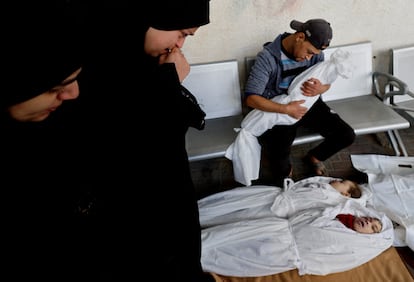The world is facing a ‘historic confluence’ of humanitarian crises, with children hit first and hardest, warns UNICEF
Gaza, Sudan, Somalia, Afghanistan, Ukraine, Pakistan… The list of conflicts and crises has never been longer or more dire. In the Gaza Strip, at least 5,000 children have been killed in just two months, with thousands more left orphaned and over 3,500 women and children still missing under the rubble, according to the U.N.


“I’m always thirsty. And hungry, but there’s barely even bread. I want to sleep, to play, to use a bathroom and take a shower.” Taha is a disabled Gazan boy who uses a wheelchair to get around and is sheltering at a U.N. school in the Gaza Strip with his family.
“Since we shot this video, the situation has gotten worse. It’s disastrous. Children are living in unprecedentedly devastating conditions. The humanitarian pause allowed families to breathe a little, but it was short-lived,” explained Laura Bill, UNICEF’s Deputy Special Representative in Palestine, in a videoconference broadcast from Jerusalem, during which she emphasized that, of the more than 1.8 million people currently displaced in Gaza, half are children.
This past Tuesday, the United Nations Children’s Fund (UNICEF) presented its 2024 Humanitarian Action Report (HAC), which estimates that in the coming year, the organization will need $9.3 billion to provide aid to 94 million children impacted by humanitarian crises across 155 countries and territories.
The organization estimates that 3.1 million people are currently in need of humanitarian assistance in Palestine, including the entire population of the Gaza Strip (2.2 million people). It is not yet possible to estimate how much funding the agency will require to assist the children of Gaza after a lasting ceasefire is achieved. The Israeli army’s bombardment and ground offensive, launched in response to the bloody attack by Hamas that killed 1,200 people and took another 200 hostage on October 7, has already killed at least 18,000 Gazans, according to Palestinian figures.
During the presentation of the group’s report in Madrid, José María Vera, the Executive Director of UNICEF Spain, urged Spanish authorities, companies and citizens to contribute to the organization to ensure that sufficient funding is available once it is possible to enter the Strip. “We must prepare our response now,” he insisted.
“The needs in Gaza go far beyond anything we have ever seen,” Laura Bill stressed. “And we will need a lot of support in order to deliver assistance to the children once we’re able to.” She estimates that at least 5,000 children have died from the violence in Gaza since October 7, and some 8,000 have been injured. In addition, she says that “some 3,500 children and women are missing under the rubble, and thousands more have been left alone, separated from parents and loved ones,” and she warns of the compounding dangers of dehydration and disease that are already affecting Gaza’s children, who are drinking bad water to survive.
Bill explained that during the humanitarian pause, UNICEF and other U.N. agencies were able to reach the northern part of Strip to deliver medical supplies, winter clothing, and food and water to the families that remained in that part of the enclave. “An estimated 200,000 people are still there,” she said. The organization also managed to retrieve batches of vaccines from hospitals in the north and bring them to the south to start a vaccination campaign with what meager resources were available. In total, during the brief suspension of Israeli bombardment, UNICEF was able to provide some kind of assistance (mainly water, food, fuel and hygiene products) to roughly one million people.
Forgotten emergencies
Gaza has drawn the world’s attention, but at the same time, thousands of Palestinian children are being forgotten and left to face emergencies without outside assistance. “Times are hard,” says Vera, of UNICEF Spain. “There are countless crises, many of them unpredictable, and the humanitarian system is under unprecedented stress. Children are the first to suffer the consequences, and they suffer them the hardest.”
The UNICEF report describes “a historic confluence” of global conflicts. In addition to crises that have become entrenched, like in Darfur or Afghanistan, there are others that get suddenly worse, as in the case of Gaza. “Some 460 million children, which is to say, one fifth of all children in the world, live in situations of conflict, and 1 billion children, or half the global total, live in areas at risk from climate change,” says Vera. In some cases, droughts or floods are compounded by violence, as in Somalia, which result in “unprecedented” mass forced displacements, as in Sudan.
With the funds requested for 2024, UNICEF plans to vaccinate more than 17 million children against measles, enable more than 19 million children to access formal and informal education, support 26.7 million children and their caregivers in receiving mental health care and psychosocial support, and provide 52 million people with access to safe water, among other programs.
Vera notes that some crises demand and receive large amounts of aid, as in the case of Ukraine, Afghanistan, Syria or the Gaza Strip, but he emphasizes that there are other emergencies where gaps in funding — that is, where there is a discrepancy between what is needed and what is fundraised — are painful. This is true for Sudan, Burkina Faso, the Democratic Republic of Congo (DRC) and Myanmar, for example, where only 20 to 25% of humanitarian needs are covered. “One of our challenges is to build access to flexible financing that can allow us to respond to a crisis immediately, or even beforehand, and that also allows us to provide a just response — that is, that assistance is not dependent on the interests of public opinion, but that each child, wherever he or she is, can receive humanitarian aid according to his or her needs,” he says.
The cost of inaction
In 2023, UNICEF estimated its total financial needs at $10.26 billion, a figure that would increase by about $800 million due to new and protracted conflicts and emergencies caused by climate change. Of this total, the U.N. agency was able to fund 38%.
For the citizens, businesses and authorities in the West, the eight million Somalis in need of humanitarian aid, or the 33 million Pakistanis, half of them children, affected by catastrophic floods, or the 12 million Afghan children in need of assistance can sound like crises too far away to merit much concern.
“No child should have to experience what young Sudanese children suffer every day: seven million children under the age of one are at risk of not receiving basic vaccinations, three million are acutely malnourished and hunger is expected to get even worse,” explained Blanca López, Program Specialist at UNICEF Sudan.
With the funds requested, UNICEF will be able to reach eight million Sudanese children, according to López. “One million children up to 59 months of age will be vaccinated against measles, 500,000 children will be treated for acute malnutrition, two million children will have access to formal and informal education, and five million people will have access to water for consumption and hygiene,” she said.
“The cost of inaction is always unacceptably high. We cannot allow the death and suffering of Sudan’s children to be a forgotten catastrophe,” López emphasized.
Sign up for our weekly newsletter to get more English-language news coverage from EL PAÍS USA Edition
Tu suscripción se está usando en otro dispositivo
¿Quieres añadir otro usuario a tu suscripción?
Si continúas leyendo en este dispositivo, no se podrá leer en el otro.
FlechaTu suscripción se está usando en otro dispositivo y solo puedes acceder a EL PAÍS desde un dispositivo a la vez.
Si quieres compartir tu cuenta, cambia tu suscripción a la modalidad Premium, así podrás añadir otro usuario. Cada uno accederá con su propia cuenta de email, lo que os permitirá personalizar vuestra experiencia en EL PAÍS.
¿Tienes una suscripción de empresa? Accede aquí para contratar más cuentas.
En el caso de no saber quién está usando tu cuenta, te recomendamos cambiar tu contraseña aquí.
Si decides continuar compartiendo tu cuenta, este mensaje se mostrará en tu dispositivo y en el de la otra persona que está usando tu cuenta de forma indefinida, afectando a tu experiencia de lectura. Puedes consultar aquí los términos y condiciones de la suscripción digital.
More information
Archived In
Últimas noticias
ICE raids trigger school absenteeism and traumatize children: ‘They have been forced to leave their childhood behind’
The guardians of the meteorites of the Argentine Chaco
Helen Levitt, the photographer who captured the theater of the everyday
The life of a delivery driver in China: ‘Many people don’t know how an order can arrive at their home in just one day’
Most viewed
- Christian Louboutin: ‘Young people don’t want to be like their parents. And if their parents wear sneakers, they’re going to look for something else’
- US sanctions against jailed cartel leader ‘El Marro’ highlight Mexico’s lack of control over its prisons
- The low-cost creative revolution: How technology is making art accessible to everyone
- Liset Menéndez de la Prida, neuroscientist: ‘It’s not normal to constantly seek pleasure; it’s important to be bored, to be calm’
- Cartels in Mexico take a leap forward with narco-drones: ‘It is criminal groups that are leading the innovation race’









































